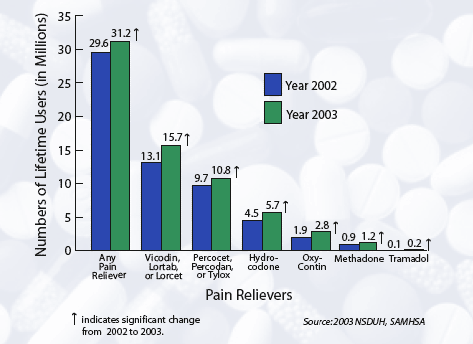2003 Survey Reveals Increase in Prescription Drug Abuse, Sharp Drop in Abuse of Hallucinogens
The annual National Survey on Drug Use and Health (NSDUH), released in September 2004, indicates that in 2003 more than 19 million Americans—8.2 percent of the population aged 12 and older—were abusing illegal drugs each month. Overall, this represents no significant change from 2002, but the new data reveal significant changes for some drugs. For example, among youth aged 12 through 17, past-year abuse of MDMA ("Ecstasy") and LSD fell sharply—by 41 percent for MDMA and 54 percent for LSD. On a less encouraging note, lifetime abuse of prescription pain medications increased in all age groups and for all painkillers in the survey. Key findings from the 2003 NSDUH:
 Lifetime Nonmedical Users of Selected Pain Relievers Among Persons Aged 12 or Older: 2002 and 2003
Lifetime Nonmedical Users of Selected Pain Relievers Among Persons Aged 12 or Older: 2002 and 2003- Tobacco. An estimated 70.8 million Americans reported current (past-month) use of a tobacco product in 2003. This is 29.8 percent of the population aged 12 or older, similar to the rate in 2002 (30.4 percent). The highest rate of past-month cigarette smoking was among young adults aged 18 to 25 (40.2 percent). Among all smokers aged 12 or older, a higher proportion of males than females smoked cigarettes in 2003 (28.1 v. 23.0 percent), but among 12- to 17-year-olds, girls (12.5 percent) were as likely as boys (11.9 percent) to smoke. Among girls in this age group, the 2003 figures represent a significant decrease from last year's rate of 13.6 percent.
- Marijuana. Marijuana is the most commonly abused illicit drug, with 14.6 million (6.2 percent of the population) persons currently abusing the drug. There were an estimated 2.6 million new marijuana users in 2002, roughly two-thirds of whom were younger than age 18; half of the new abusers were female. The 2003 data reveal a drop of 20 percent in the number of youth who reported heavy (either daily or 20 or more days per month) use of marijuana. Significantly higher numbers of youth and young adults said they believe there is a significant health risk associated with smoking marijuana.
- Hallucinogens. The number of current abusers of MDMA decreased between 2002 and 2003, from 676,000 (0.3 percent) to 470,000 (0.2 percent). Past-year abuse of Ecstasy declined (from 3.2 million to 2.1 million abusers), as did past-year abuse of LSD (from 1 million to 558,000 abusers) between 2002 and 2003.
- Prescription Drug Abuse. An estimated 6.3 million persons (2.7 percent) aged 12 or over engaged in current nonmedical use of psychoactive therapeutic drugs. Of these, 4.7 million abused pain relievers, 1.8 million abused tranquilizers, 1.2 million abused stimulants, and 0.3 million abused sedatives. There was a significant increase in lifetime nonmedical use of pain relievers between 2002 and 2003 among persons aged 12 or older, with young adults (18-25) reporting a 15 percent increase in lifetime and current (past-month) use.
The 2003 survey report is based on interviews concerning use of alcohol, tobacco, and drugs with 67,784 respondents aged 12 and older. Lifetime use is defined as having ever used a substance in one's lifetime. Past-year use is having used the substance at least once in the past 12 months. Current use is use in the past 30 days.
